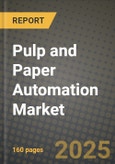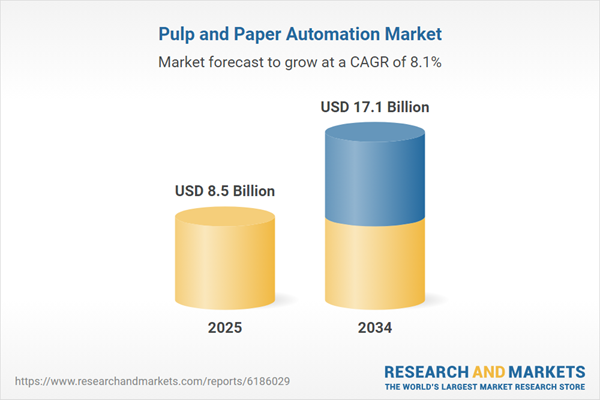Pulp and Paper Automation Market Overview
The pulp and paper automation market plays a vital role in transforming traditional manufacturing processes into highly efficient, cost-effective, and sustainable operations. Automation solutions in this sector include distributed control systems (DCS), programmable logic controllers (PLC), quality control systems (QCS), machine vision, and advanced analytics, all designed to optimize energy consumption, reduce operational errors, and ensure product quality. As the pulp and paper industry faces rising pressure from environmental regulations, fluctuating raw material prices, and increased demand for customized products, automation offers a pathway to maintain competitiveness. Additionally, the shift toward smart factories and Industry 4.0 adoption is prompting manufacturers to invest in integrated automation systems that support real-time monitoring, predictive maintenance, and data-driven decision-making. With digital transformation becoming a top priority, automation is not only streamlining production but also enhancing supply chain coordination and workforce safety within pulp and paper mills globally.The pulp and paper automation market saw a significant uptick in activity as manufacturers prioritized digital upgrades to address operational inefficiencies and environmental goals. Companies increasingly adopted cloud-based monitoring tools, AI-powered predictive maintenance systems, and energy management platforms to reduce downtime and optimize resource use. The integration of IoT sensors across production lines improved data collection, enabling better control over process variables such as pulp consistency, moisture levels, and fiber alignment. North America and Europe led the way in implementing smart mill initiatives, while Asia-Pacific markets, particularly China and India, focused on automation retrofits in aging plants. Leading vendors introduced modular automation systems that allowed incremental implementation, reducing capital burden and enabling flexibility. Furthermore, automation was key in supporting sustainable packaging trends, as producers sought greater precision in material usage to reduce waste. While automation enhanced efficiency, skill gaps in handling complex systems created new training and workforce development needs.
The pulp and paper automation market is poised for sustained growth, driven by continued digitalization, regulatory compliance, and demand for sustainable operations. AI and machine learning algorithms will become more embedded in control systems, offering adaptive production planning and real-time quality corrections. As energy costs rise, mills will increasingly deploy automation to optimize boiler and turbine operations, contributing to decarbonization efforts. The industry will also witness greater use of digital twins to simulate production environments, allowing for predictive scenario planning and reduced waste. Vendors will expand their service offerings with remote monitoring, cybersecurity solutions, and automation-as-a-service models to meet the evolving needs of both large mills and smaller regional operators. Governments and industry associations are expected to provide incentives and training initiatives to accelerate automation adoption, particularly in emerging markets. The future of this market will depend on balancing innovation with workforce adaptability, system interoperability, and long-term return on investment.
Key Insights: Pulp and Paper Automation Market
- Increased adoption of AI and predictive maintenance tools is helping mills reduce unplanned downtime, extend equipment life, and improve operational efficiency.
- Modular automation systems are gaining traction, allowing incremental upgrades and customization in response to changing production requirements and budgets.
- Digital twin technology is being explored for process simulation and optimization, enabling real-time analysis and cost-saving predictions.
- Cloud-based control and monitoring platforms are improving remote access, scalability, and integration across decentralized production facilities.
- Automation is playing a key role in supporting sustainable paper production by minimizing waste, reducing energy use, and enhancing material precision.
- Growing demand for efficient and sustainable manufacturing processes is driving investment in automation across the pulp and paper industry.
- Regulatory pressure to reduce emissions and environmental impact is pushing mills to adopt energy-efficient, automated systems.
- Rising raw material and labor costs are encouraging manufacturers to streamline operations and reduce dependency on manual labor.
- Expansion of smart packaging and custom paper products is requiring higher production flexibility and real-time quality control enabled by automation.
- Workforce skill gaps and resistance to technological change are limiting the speed of automation adoption, particularly in regions where training and technical support are insufficient to manage complex automated systems.
Pulp and Paper Automation Market Segmentation
By Product
- Distributed Control Systems (DCS)
- Programmable Logic Controllers (PLCs)
- Supervisory Control and Data Acquisition (SCADA)
- Sensors and Transmitters
- Flowmeters
- Manufacturing Execution Systems (MES)
- Asset Performance Management (APM)
- Advanced Process Control (APC)
- Other Products
By Application
- Pre-Press Printing
- Print and Publication
- Paper Mills Processing
- Paper Packaging
By End-User
- Paper
- Pulp
- Tissue
- Board
Key Companies Analysed
- Microsoft Corporation
- Hitachi Ltd.
- Amazon Web Services Inc.
- Siemens AG
- General Electric Company
- IBM Corporation
- Oracle Corporation
- Schneider Electric SE
- Honeywell International Inc.
- SAP SE
- ABB Ltd.
- Emerson Electric Co.
- Parker Hannifin Corporation
- Andritz AG
- Rockwell Automation Inc.
- Omron Corporation
- Fanuc Corporation
- Fuji Electric Co. Ltd.
- Baker Hughes Company
- NV Bekaert SA
- BTG Group BV
- Metso Corporation
- Valmet Corporation
- Voith Group
- Yaskawa Electric Corporation
- Pentair plc
- Ecolab Inc. (formerly Nalco Holding Company)
- Yokogawa Electric Corporation
- Solenis LLC
- Kemira Oyj
Pulp and Paper Automation Market Analytics
The report employs rigorous tools, including Porter’s Five Forces, value chain mapping, and scenario-based modeling, to assess supply-demand dynamics. Cross-sector influences from parent, derived, and substitute markets are evaluated to identify risks and opportunities. Trade and pricing analytics provide an up-to-date view of international flows, including leading exporters, importers, and regional price trends.Macroeconomic indicators, policy frameworks such as carbon pricing and energy security strategies, and evolving consumer behavior are considered in forecasting scenarios. Recent deal flows, partnerships, and technology innovations are incorporated to assess their impact on future market performance.
Pulp and Paper Automation Market Competitive Intelligence
The competitive landscape is mapped through proprietary frameworks, profiling leading companies with details on business models, product portfolios, financial performance, and strategic initiatives. Key developments such as mergers & acquisitions, technology collaborations, investment inflows, and regional expansions are analyzed for their competitive impact. The report also identifies emerging players and innovative startups contributing to market disruption.Regional insights highlight the most promising investment destinations, regulatory landscapes, and evolving partnerships across energy and industrial corridors.
Countries Covered
- North America - Pulp and Paper Automation market data and outlook to 2034
- United States
- Canada
- Mexico
- Europe - Pulp and Paper Automation market data and outlook to 2034
- Germany
- United Kingdom
- France
- Italy
- Spain
- BeNeLux
- Russia
- Sweden
- Asia-Pacific - Pulp and Paper Automation market data and outlook to 2034
- China
- Japan
- India
- South Korea
- Australia
- Indonesia
- Malaysia
- Vietnam
- Middle East and Africa - Pulp and Paper Automation market data and outlook to 2034
- Saudi Arabia
- South Africa
- Iran
- UAE
- Egypt
- South and Central America - Pulp and Paper Automation market data and outlook to 2034
- Brazil
- Argentina
- Chile
- Peru
Research Methodology
This study combines primary inputs from industry experts across the Pulp and Paper Automation value chain with secondary data from associations, government publications, trade databases, and company disclosures. Proprietary modeling techniques, including data triangulation, statistical correlation, and scenario planning, are applied to deliver reliable market sizing and forecasting.Key Questions Addressed
- What is the current and forecast market size of the Pulp and Paper Automation industry at global, regional, and country levels?
- Which types, applications, and technologies present the highest growth potential?
- How are supply chains adapting to geopolitical and economic shocks?
- What role do policy frameworks, trade flows, and sustainability targets play in shaping demand?
- Who are the leading players, and how are their strategies evolving in the face of global uncertainty?
- Which regional “hotspots” and customer segments will outpace the market, and what go-to-market and partnership models best support entry and expansion?
- Where are the most investable opportunities - across technology roadmaps, sustainability-linked innovation, and M&A - and what is the best segment to invest over the next 3-5 years?
Your Key Takeaways from the Pulp and Paper Automation Market Report
- Global Pulp and Paper Automation market size and growth projections (CAGR), 2024-2034
- Impact of Russia-Ukraine, Israel-Palestine, and Hamas conflicts on Pulp and Paper Automation trade, costs, and supply chains
- Pulp and Paper Automation market size, share, and outlook across 5 regions and 27 countries, 2023-2034
- Pulp and Paper Automation market size, CAGR, and market share of key products, applications, and end-user verticals, 2023-2034
- Short- and long-term Pulp and Paper Automation market trends, drivers, restraints, and opportunities
- Porter’s Five Forces analysis, technological developments, and Pulp and Paper Automation supply chain analysis
- Pulp and Paper Automation trade analysis, Pulp and Paper Automation market price analysis, and Pulp and Paper Automation supply/demand dynamics
- Profiles of 5 leading companies - overview, key strategies, financials, and products
- Latest Pulp and Paper Automation market news and developments
Additional Support
With the purchase of this report, you will receive:- An updated PDF report and an MS Excel data workbook containing all market tables and figures for easy analysis.
- 7-day post-sale analyst support for clarifications and in-scope supplementary data, ensuring the deliverable aligns precisely with your requirements.
- Complimentary report update to incorporate the latest available data and the impact of recent market developments.
This product will be delivered within 1-3 business days.
Table of Contents
Companies Mentioned
- Microsoft Corporation
- Hitachi Ltd.
- Amazon Web Services Inc.
- Siemens AG
- General Electric Company
- IBM Corporation
- Oracle Corporation
- Schneider Electric SE
- Honeywell International Inc.
- SAP SE
- ABB Ltd.
- Emerson Electric Co.
- Parker Hannifin Corporation
- Andritz AG
- Rockwell Automation Inc.
- Omron Corporation
- Fanuc Corporation
- Fuji Electric Co. Ltd.
- Baker Hughes Company
- NV Bekaert SA
- BTG Group BV
- Metso Corporation
- Valmet Corporation
- Voith Group
- Yaskawa Electric Corporation
- Pentair PLC
- Ecolab Inc. (formerly Nalco Holding Company)
- Yokogawa Electric Corporation
- Solenis LLC
- Kemira Oyj
Table Information
| Report Attribute | Details |
|---|---|
| No. of Pages | 160 |
| Published | October 2025 |
| Forecast Period | 2025 - 2034 |
| Estimated Market Value ( USD | $ 8.5 Billion |
| Forecasted Market Value ( USD | $ 17.1 Billion |
| Compound Annual Growth Rate | 8.1% |
| Regions Covered | Global |
| No. of Companies Mentioned | 30 |









